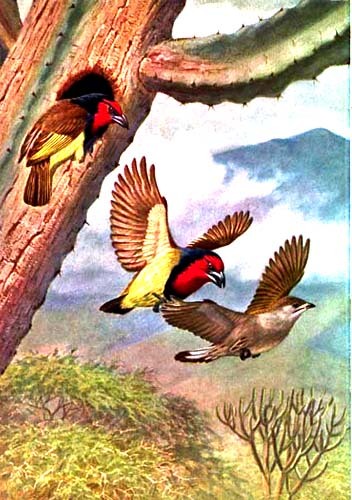Honeyguides: Ontogeny
How did the guiding behavior develop?
(Image:
Walter A. Weber)
There
is debate over whether or not honeyguides developed this behavior
in response to early humans, or the honey badger, the "ratel". While
African tribes have long told of the mutually beneficial cooperation
between the honeyguide and the ratel, this has never been observed by
biologists, although most seem to accept it as fact. The guiding of
humans by the birds, however, has. Either
way, it's assumed that early on a honeyguide observed a human (or
ratel) opening a hive, and consequently was able to partake of the
scraps left behind. This would have encouraged the bird to follow the
other animal in order if it could find even more food.
Since a honeyguide is familiar with the locations of all the hives in
its territory, it would seem logical for the bird to have started to
try to lead the animal to hives that the honeyguide had no access to.
This doesn't require any guiding in the early stages, simply drawing
the attention of the animal to the hive by circling or making loud
noises. After this happened several times, the animal may come to
realize that the honeyguide is a reliable source of information for
food, and would have been willing to follow the bird greater distances
in pursuit of hives.
The
guiding behavior was probably originally established through
learning and habituation in one specific bird, which spread - either
through imitation or communication - to its peers and progeny. However,
it is unknown how this behavior became instinctive, as it is thought to
be because honeyguides are parasitic breeders. They lay their
eggs in the nests of other birds, so the nestlings would not have an
opportunity to learn the behavior from the parents. Consequently,
because the host parents do not eat wax, the honeyguide chicks do not
learn to eat it in their youth. However, all adult honeyguides
instinctly seek out honeycombs in order to ingest the wax and larvae
available there. The behavior seems to be unique to a certain population, however - those honeyguides in the same area as other honey-gathering organisms. Honeyguides in areas where humans no longer need to search for bee colonies do not display this behavior - either because they lost it, or simply never learned to do it.